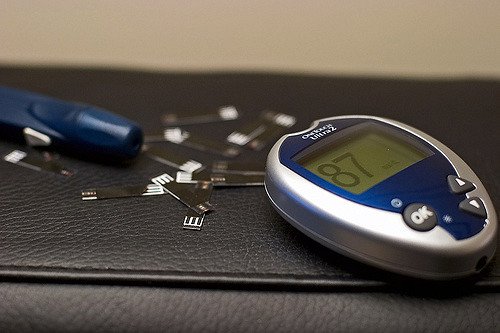Borderline Diabetics At Risk for Gum Disease
Researchers have discovered a link between borderline diabetes and gum disease. Learn how pre-diabetics are at a much greater risk for developing gum disease.

Photo by Sriram Bala on Flickr.
Diabetes is a major health condition, affecting more than 29.1 million people in the United States, or approximately 9.3% of the U.S. population. According to the American Diabetes Association, more than 70,000 people die each year from complications associated with diabetes. Diabetes is known to be a major cause of kidney failure, blindness, heart disease, and stroke.
The buildup of plaque is a major cause of gum disease, but did you know that diabetes may cause gum disease as well?
In recent years, researchers discovered a link between gum disease and diabetes. It was first thought that people with full-blown diabetes were at risk for developing gum disease. The issue is that people with diabetes are generally more susceptible to bacterial infections and have a weakened ability to fight bacteria that invade the gums. This means they have an increased risk for developing periodontitis, a severe form of gum disease.
But now, more recent studies are indicating that even those with a pre-diabetic condition are at a greater risk of gum disease.
Pre-Diabetes and Gum Disease - A Vicious Cycle
Pre-diabetes is a condition where the blood glucose levels are higher than normal, but still within the normal range. It is not diabetes and may not even progress to full-blown diabetes, but it is still a serious consideration for both our dental health and our overall health. There are thought to be anywhere from 60 to 80 million Americans who are in the pre-diabetic range.
But to complicate matters, researchers have also discovered that there is a circular effect when it comes to diabetes and gum disease. It seems that pre-diabetic people may be at a greater risk for gum disease and people with gum disease have an increased risk for developing a pre-diabetic condition. Uncontrolled gum disease may even increase the progression of diabetes for pre-diabetics.
A study found that people with clinical signs of gum disease were more likely to have glucose level problems, a common symptom for diabetics. Clinical signs of gum disease include inflammation of the gums and bleeding gums during a dental exam.
How does gum disease relate to glucose levels?
As it turns out, gum infections can raise blood glucose levels. The high blood glucose makes it harder to fight infections, weakening white blood cells called neutrophils and disabling their ability to kill the bacteria.
Additionally, periodontitis may increase levels of inflammatory cytokines and serum lipids. According to researchers at Marquette University, the cytokines can produce an insulin resistance syndrome similar to that observed in diabetes and initiate destruction of pancreatic beta cells leading to development of diabetes. And researchers have also proposed that gum disease could alter the metabolic process of glucose regulation, potentially contributing to a person's progression toward type 2 diabetes.
All people have thousands of bacteria in their mouths and this is normal. But when left to thrive, bad bacteria causes chronic inflammation in the gums which destroys the gums and damages our teeth and bones. This is especially important for people with diabetes. A diabetes condition that is not under control can put the patient under a higher risk of developing gum disease.
Other Problems Associated with Uncontrolled Blood Glucose Levels
Uncontrolled diabetes can also cause other oral problems including oral thrush, a yeast infection called candidiasis caused by fungus that grows in the mouth, and dry mouth which can cause soreness, ulcers, infections, and cavities. The yeast in thrush thrive on the high amounts of sugar found in the saliva and it can look like a white layer that coats the tongue and the insides of the cheeks.
Diabetes also typically interferes with the salivary gland's ability to produce saliva, resulting in dry mouth. But the saliva helps protect our teeth by washing away bacteria and food particles. When the saliva production decreases, it creates an ideal environment for bacteria to grow, leading to inflamed and bleeding gums and even cavities and tooth decay. People with diabetes may also be more susceptible to infections inside the mouth and have problems tasting food. Children with diabetes may also experience teeth erupting at an earlier age than is typical.
Diabetes can also take a toll on the taste buds, making patients more inclined to add sugar to food in an effort to add flavor. This not only affects the quality of the diet, but it can also lead to more cavities.
Both conditions, diabetes and gum disease, cause inflammation throughout the whole body. The inflammatory cytokines inflame the blood vessels, creating small scars. Eventually, the blood vessels can become clogged with plaque, and such blockages are linked to major complications of diabetes, including heart disease, kidney disease, and strokes.
Researchers conducted a study in Bangalore, India on 200 people. Half of the subjects had had recent strokes or heart attacks. The researchers took into account family history of stroke, diet, smoking, alcohol consumption, diabetes, hypertension, total serum cholesterol level, and education level. The individuals with gum pockets that were deeper than 4.5 millimeters had a higher risk of strokes.
Does that mean that everyone who develops gum disease will develop diabetes? Not necessarily. The research so far only suggests that a connection exists between gum disease and diabetes, either pre-diabetes or full-blown. If one condition exists, the risk of developing the other increases.
Gum Disease and Diabetes Management
Since the bacteria in our mouths have the power to lead to major health conditions, such as diabetes and heart disease, it behooves us to make our dental care a priority. By addressing gum infections and gum disease right away, we give our immune systems the chance to fight other infections that threaten our bodies.
According to the CDC, half of American adults have periodontal (or gum) disease. Gingivitis, a mild form of gum disease, can usually be treated effectively with daily brushing and flossing and regular teeth cleanings at the dentist's office.
A visit with your physician may include blood tests to determine whether or not you have diabetes or are in the pre-diabetic range. If test results indicate that your blood glucose levels are high, you will need to maintain good control of your blood glucose levels through proper diet and exercise. Your physician will be able to give you recommendations on controlling these levels and may even refer you to a nutritionist who specializes in working with diabetic individuals.
Since a diagnosis of diabetes may affect how gum disease is treated, you will want to let your dentist know, along with any medications you may be taking, so he can determine the best course of action. The American Diabetes Association says that before having any non-emergency dental work done, you will need to get your blood glucose levels under control.
While diabetes and gum disease can lead to potentially serious health conditions, they can also be successfully managed with proper care and treatment.
Symptoms of Diabetes
According to the American Diabetes Association, early signs of diabetes may include:
-
Frequent urination
-
Feeling very thirsty or hungry
-
Extreme fatigue
-
Blurry vision
-
Slow healing of cuts and bruises
-
Weight loss despite eating more (type 1)
-
Tingling, pain, or numbness in the extremities (type 2)
If you are experiencing any of these symptoms, a visit with your physician may be in order. Blood test results may come back negative, but knowing for sure will clear the air and take the stress off. And if results come back positive, at least treatment can be handled as soon as possible rather than waiting for fear of a diagnosis.
It is also important to keep in mind that, for some people with type 2 diabetes, symptoms are so mild that they go unnoticed. The American Diabetes Association estimates that nearly 7 million people in the United States have undiagnosed diabetes. A blood test can shed light on your overall health. Diabetes may weaken your ability to fight germs which increases the risk of infection in your gums and in the bones that hold your teeth in place. If your gums start to pull away from your teeth, your teeth may become loose, or you may develop sores or pockets of pus in your gums.
Other Notable Warning Signs
Other warning signs of gum disease include bleeding gums when you brush or floss; red, swollen, or tender gums; gums that have pulled away from the teeth; pus between the teeth and gums; bad breath; loose teeth; changes in the way your teeth fit when you bite; and changes in the fit of partial dentures or bridges. It is important to note that bleeding gums is not normal and is usually a sign of a gum infection. If left untreated, it can lead to more serious issues such as gum recession and tooth decay. And often gum disease is painless.
For people who are considered pre-diabetic, getting gum disease addressed regularly should theoretically help them stay within the pre-diabetic range, provided they do not experience other issues that would exacerbate the issue.
The Good News…
The good news is that we can take charge of our health right now. Maintaining a healthy diet, one that helps you control your blood glucose levels, will also help you with your oral health. Combined with regular brushing, flossing, and dental cleanings, it can go a long way in helping give your immune system a better chance of fighting infections that attack the body, whether in your mouth or in the rest of your body, and helping to decrease the likelihood of developing diabetes-related mouth issues.
Resources:
http://www.diabetesselfmanagement.com/blog/diabetes-and-your-gums/
http://www.mayoclinic.org/diseases-conditions/diabetes/in-depth/diabetes-symptoms/art-20044248
http://www.mouthhealthy.org/en/az-topics/d/diabetes





